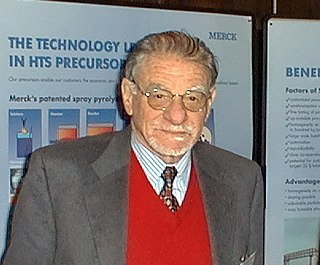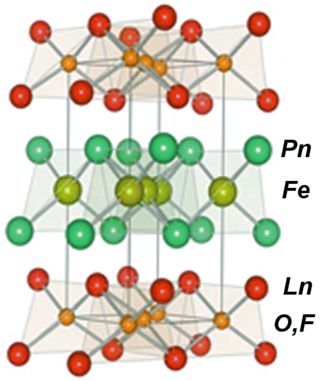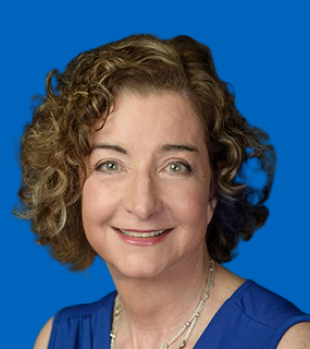Related Research Articles

Superconductivity is a set of physical properties observed in certain materials where electrical resistance vanishes and magnetic fields are expelled from the material. Any material exhibiting these properties is a superconductor. Unlike an ordinary metallic conductor, whose resistance decreases gradually as its temperature is lowered, even down to near absolute zero, a superconductor has a characteristic critical temperature below which the resistance drops abruptly to zero. An electric current through a loop of superconducting wire can persist indefinitely with no power source.
Unconventional superconductors are materials that display superconductivity which does not conform to conventional BCS theory or its extensions.

High-temperature superconductors are defined as materials with critical temperature above 77 K, the boiling point of liquid nitrogen. They are only "high-temperature" relative to previously known superconductors, which function at even colder temperatures, close to absolute zero. The "high temperatures" are still far below ambient, and therefore require cooling. The first break through of high-temperature superconductor was discovered in 1986 by IBM researchers Georg Bednorz and K. Alex Müller. Although the critical temperature is around 35.1 K, this new type of superconductor was readily modified by Ching-Wu Chu to make the first high-temperature superconductor with critical temperature 93 K. Bednorz and Müller were awarded the Nobel Prize in Physics in 1987 "for their important break-through in the discovery of superconductivity in ceramic materials". Most high-Tc materials are type-II superconductors.

Yttrium barium copper oxide (YBCO) is a family of crystalline chemical compounds that display high-temperature superconductivity; it includes the first material ever discovered to become superconducting above the boiling point of liquid nitrogen [77 K ] at about 93 K.
Cuprates are a class of compounds that contain copper (Cu). They can be broadly categorized into two main types:

Superconductivity is the phenomenon of certain materials exhibiting zero electrical resistance and the expulsion of magnetic fields below a characteristic temperature. The history of superconductivity began with Dutch physicist Heike Kamerlingh Onnes's discovery of superconductivity in mercury in 1911. Since then, many other superconducting materials have been discovered and the theory of superconductivity has been developed. These subjects remain active areas of study in the field of condensed matter physics.

Bismuth strontium calcium copper oxide (BSCCO, pronounced bisko), is a type of cuprate superconductor having the generalized chemical formula Bi2Sr2Can−1CunO2n+4+x, with n = 2 being the most commonly studied compound (though n = 1 and n = 3 have also received significant attention). Discovered as a general class in 1988, BSCCO was the first high-temperature superconductor which did not contain a rare-earth element.

Johannes Georg Bednorz is a German physicist who, together with K. Alex Müller, discovered high-temperature superconductivity in ceramics, for which they shared the 1987 Nobel Prize in Physics.

Karl Alexander Müller was a Swiss physicist and Nobel laureate. He received the Nobel Prize in Physics in 1987 with Georg Bednorz for their work in superconductivity in ceramic materials.
Cuprate superconductors are a family of high-temperature superconducting materials made of layers of copper oxides (CuO2) alternating with layers of other metal oxides, which act as charge reservoirs. At ambient pressure, cuprate superconductors are the highest temperature superconductors known. However, the mechanism by which superconductivity occurs is still not understood.

Iron-based superconductors (FeSC) are iron-containing chemical compounds whose superconducting properties were discovered in 2006. In 2008, led by recently discovered iron pnictide compounds, they were in the first stages of experimentation and implementation..
In chemistry, oxypnictides are a class of materials composed of oxygen, a pnictogen and one or more other elements. Although this group of compounds has been recognized since 1995, interest in these compounds increased dramatically after the publication of the superconducting properties of LaOFeP and LaOFeAs which were discovered in 2006 and 2008. In these experiments the oxide was partly replaced by fluoride.

Lanthanum barium copper oxide, or LBCO, is an inorganic compound with the formula CuBa0.15La1.85O4. It is a black solid produced by heating an intimate mixture of barium oxide, copper(II) oxide, and lanthanum oxide in the presence of oxygen. The material was discovered in 1986 and was the first high temperature superconductor. Johannes Georg Bednorz and K. Alex Müller shared the 1987 Nobel Prize in physics for the discovery that this material exhibits superconductivity at the then unusually high temperature. This finding led to intense and fruitful efforts to generate other cuprate superconductors.
Superstripes is a generic name for a phase with spatial broken symmetry that favors the onset of superconducting or superfluid quantum order. This scenario emerged in the 1990s when non-homogeneous metallic heterostructures at the atomic limit with a broken spatial symmetry have been found to favor superconductivity. Before a broken spatial symmetry was expected to compete and suppress the superconducting order. The driving mechanism for the amplification of the superconductivity critical temperature in superstripes matter has been proposed to be the shape resonance in the energy gap parameters ∆n that is a type of Fano resonance for coexisting condensates.

Laura H. Greene is the Marie Krafft Professor of Physics at Florida State University and chief scientist at the National High Magnetic Field Laboratory. She was previously a professor of physics at the University of Illinois at Urbana-Champaign. In September 2021, she was appointed to the President's Council of Advisors on Science and Technology (PCAST).
LSAT is the most common name for the inorganic compound lanthanum aluminate - strontium aluminium tantalate, which has the chemical formula (LaAlO3)0.3(Sr2TaAlO6)0.7 or its less common alternative: (La0.18Sr0.82)(Al0.59Ta0.41)O3. LSAT is a hard, optically transparent oxide of the elements lanthanum, aluminium, strontium and tantalum. LSAT has the perovskite crystal structure, and its most common use is as a single crystal substrate for the growth of epitaxial thin films.
Akhoury Purnendu Bhusan Sinha is an Indian solid state chemist and a former head of the Physical Chemistry Division of the National Chemical Laboratory, Pune. He is known for his theories on semiconductors and his studies on synthesis of manganites. He is an elected fellow of the Indian National Science Academy and the Indian Academy of Sciences. The Council of Scientific and Industrial Research, the apex agency of the Government of India for scientific research, awarded Sinha the Shanti Swarup Bhatnagar Prize for Science and Technology, one of the highest Indian science awards, in 1972, for his contributions to chemical sciences.

Thomas Maurice Rice, known professionally as Maurice Rice, is an Irish theoretical physicist specializing in condensed matter physics.
John F. Mitchell is an American chemist and researcher. He is the deputy director of the materials science division at the U.S. Department of Energy's (DOE) Argonne National Laboratory and leads Argonne's Emerging Materials Group.

Lanthanum cuprate usually refers to the inorganic compound with the formula CuLa2O4. The name implies that the compound consists of a cuprate (CuOn]2n-) salt of lanthanum (La3+). In fact it is a highly covalent solid. It is prepared by high temperature reaction of lanthanum oxide and copper(II) oxide follow by annealing under oxygen.
References
- ↑ "Académie des sciences".
- ↑ L. ER Rakho, C. Michel, J. Provost et B. Raveau, « A series of oxygen-defect perovskites containing CuII and CuIII: The oxides La
3−xLn
xBa
3[CuII
5−2yCuIII
1+2y]O
14+y », J. Solid State Chem., vol. 37, no 2, avril 1981, p. 151–156 (DOI 10.1016/0022-4596(81)90080-3) - ↑ Johannes Georg Bednorz et Karl Alexander Müller, « Possible High Tc Superconductivity in the Ba-La-Cu-O System », Z. Phys. B Condens. Matter, vol. 64, no 2, 1986, p. 189–193 (DOI 10.1007/BF01303701)
- ↑ Azar Khalatbari,« Bernard Raveau, 57 ans, invente les matériaux du futur à l'université de Caen. Mais il reste surtout celui qui aurait pu partager le Nobel de physique en 1987. Ce chercheur n'a pas de prix. », Libération , 12 mai 1998, lire en ligne
- ↑ "C.V. de Bernard Raveau" (PDF). Académie des sciences. Archived from the original (PDF) on 27 October 2014. Retrieved 7 May 2011.